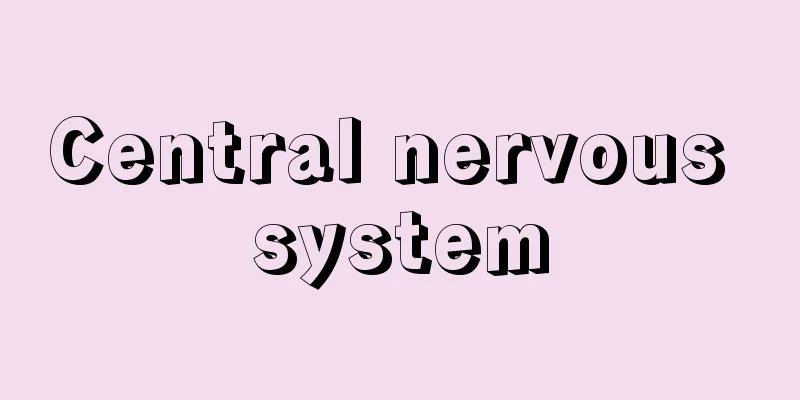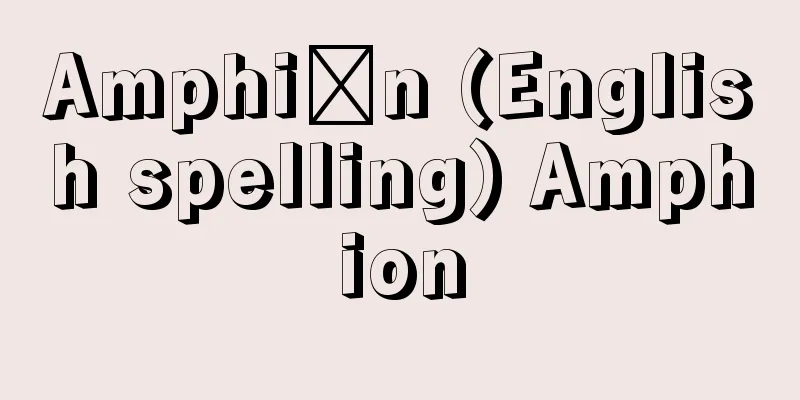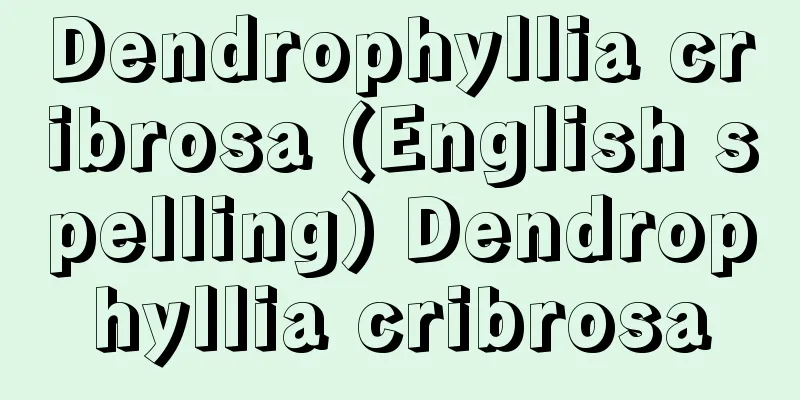Central nervous system

|
The nervous system is broadly divided into the central nervous system and the peripheral nervous system. The central nervous system refers to the brain and spinal cord, while the peripheral nervous system connects these to various organs (muscles, glands, sensory organs, etc.). The brain and spinal cord are surrounded by three membranes (dura mater, arachnoid mater, and pia mater) and are contained within the skull and spinal canal. Cerebrospinal fluid fills the space between the pia mater and arachnoid mater, preventing external shocks from resonating at their full strength to the brain. The brain, which fits within the skull, is divided into the cerebrum and cerebellum. The cerebrum is made up of the left and right cerebral hemispheres and the rod-shaped brain stem sandwiched between them. [Torii Shizuo] Cerebral hemispheresThe cerebral cortex, which covers the surface of the cerebral hemispheres, has many grooves. Among them, the central sulcus (Rolandic sulcus) and the lateral sulcus (Silvian sulcus) are deep grooves. The area in front of them is called the frontal lobe, and the area behind them is further divided into the parietal lobe, occipital lobe, and temporal lobe for convenience. The two cerebral hemispheres, left and right, are connected by a part called the corpus callosum. If you cut the cerebral hemisphere horizontally, you will see that the surface is bordered by a thin gray-white layer, which is the cerebral cortex, where nerve cells are densely packed in a layered structure. The inside of the cerebral cortex is white, which is a collection of nerve fibers called white matter (medulla). There are several gray-white masses in the medulla. These are groups of nerve cells called cerebral nuclei. The cerebral nuclei are divided into the caudate nucleus, putamen, globus pallidus, amygdala, and septum. The caudate nucleus, putamen, and globus pallidus are relay sites for the efferent nerves emanating from the neocortex, while the amygdala and septum are relay sites for the efferent nerves emanating from the limbic cortex. All of these are primarily involved in the expression of movement. [Torii Shizuo] Brain stemThe brainstem is divided into the diencephalon, midbrain, pons, and medulla oblongata. In humans, the diencephalon and pons are particularly well developed, which is due to the development of the cerebral cortex. The midbrain in humans is less developed than in other animals. On the back of the brainstem, there are four elevations (tetragamous body) called the superior colliculus and inferior colliculus. The superior colliculus is related to vision, and the inferior colliculus is related to hearing. The brainstem also contains the red nucleus and substantia nigra, which are related to movement. In the center from the midbrain to the medulla oblongata, there is a region called the reticular formation, which is a network of nerve cells, and is related to the physiological mechanism of consciousness. Within this reticular formation are monoamine nerve cells (nerve cells that use dopamine, noradrenaline, and serotonin as transmitters), which play important roles in learning, memory, sleep, and awakening. Dopaminergic nerve cells are located in the midbrain and project from here to the cerebral nuclei and cerebral cortex. Noradrenergic neurons are found in the locus coeruleus, and serotonergic neurons are found in the raphe nucleus. In addition, the brainstem contains centers related to breathing, blood vessels, and the heart, and 10 pairs of cranial nerves other than the optic nerve and olfactory nerve originate from the midbrain, pons, and medulla oblongata. The diencephalon is anatomically divided into the thalamus, epithalamus, hypothalamus, and posterior thalamus. The thalamus is morphologically divided into six nuclei (midline, anterior, medial, lateral, ventral, and posterior). In terms of function, the thalamus is divided into special nuclei, which are relay points for sensory nerves ascending to the cerebral cortex, non-special nuclei, which are relay points for nerves projecting widely from the reticular formation to the cerebral cortex, and association nuclei, which receive fibers from other nuclei in the thalamus. The posterior thalamus contains the lateral geniculate nucleus, which relays sensory nerves from the eyes, and the medial geniculate nucleus, which relays sensory nerves from the ears. The hypothalamus is a small part in the wall of the third ventricle, and is composed of many nuclei. In terms of function, the hypothalamus is divided into anterior and posterior, or medial and lateral. The hypothalamus is the center of the autonomic nervous system, and also has a mechanism for maintaining and regulating the activity level of the cerebral cortex. The hypothalamus also sends fibers to the pituitary gland to control the secretion of hormones. [Torii Shizuo] cerebellumThe cerebellum is an oval body with a narrowed center that sits on top of the pons and medulla oblongata; the narrowed part is called the vermis, and the bulging parts on either side are called the cerebellar hemispheres. The vermis receives nerve fibers entering and exiting the cerebellum and regulates the body's balance and posture; it is also found in lower animals (it is called the paleocerebellum). In contrast, the cerebellar hemispheres receive nerve fibers from sensory organs such as muscles and skin, and also have nerve fiber connections to the cerebral cortex, controlling skilled limb movements. The cerebellar hemispheres only appear in mammals, and are called the neocerebellum. [Torii Shizuo] Spinal cordThe spinal cord is a white cord-like body 42-45 cm long that is contained within the vertebrae (vertebral column). 31 pairs of spinal nerves (8 pairs of cervical nerves, 12 pairs of thoracic nerves, 5 pairs of lumbar nerves, 5 pairs of sacral nerves, and 1 pair of coccygeal nerves) emerge from both sides of the spinal cord, which is divided into the cervical, thoracic, lumbar, and sacral spinal cord (including the coccygeal nerve). When the spinal cord is cut horizontally, there is an H-shaped gray matter in the center surrounded by white matter. The gray matter is divided into anterior columns, lateral columns, and posterior columns, each of which is home to nerve cells with different shapes and properties. The large nerve cells in the anterior columns are called motor nerve cells because they receive various information from the brain and reflex pathways, integrate it, and send it to muscles as motor commands. They are also called the final common pathway because of their function. The posterior columns contain nerve cells that belong to the sensory nerves, and the lateral columns contain nerve cells that belong to the autonomic nervous system. White matter is a bundle of nerve fibers that mainly ascend vertically (sensory nerves) or descend vertically (motor nerves, autonomic nerves), and these bundles of nerves are called pathways. The main function of the human spinal cord is to act as a nerve pathway that transmits signals from the sensory organs and commands to the muscles, but it also performs an integrative function. The simplest example of this is the spinal reflex. [Torii Shizuo] Central nervous system in animalsThe central nervous system is a collection of nerve cells and nerve fibers that are formed as a result of centralization of the nervous system, and these collections are interconnected to form the central nervous system both morphologically and functionally. In vertebrates, the brain and spinal cord are the central nervous system, while the peripheral nervous system is the nervous system that receives information from each part of the body and sends it to the brain and spinal cord, and transmits information from the brain and spinal cord to each part of the body. The simplest function of the central nervous system is the expression of reflex behavior when sensory neurons transmit information from sensory receptors to motor neurons, but in many cases, many neurons intervene between sensory neurons and motor neurons to form complex neural circuits that not only coordinate activities, but also control advanced neural activities in animals with a well-developed cerebral cortex. In invertebrates, collections of nerve cells can be seen in jellyfish, but the true central nervous system is seen in flatworms and above. The central nervous system of invertebrates consists of ganglia, which are collections of nerve cells, and bundles of nerve fibers called nerve cords that connect the ganglia. A typical example is the ladder-shaped nervous system found in annelids and arthropods. Although its shape is different from that of vertebrates, it is the same in that it transmits, recognizes, and integrates changes sensed inside and outside the body, and adjusts the body to respond according to the situation. [Yasumi Arai] [Reference] | | |©Shogakukan "> Components of the central nervous system Source: Shogakukan Encyclopedia Nipponica About Encyclopedia Nipponica Information | Legend |
|
神経系は、中枢神経系と末梢(まっしょう)神経系とに二大別される。中枢神経系とは脳と脊髄(せきずい)とをいい、これらとさまざまな器官(筋肉、腺(せん)、感覚器など)を連結するものを末梢神経系という。脳と脊髄とは、三重の膜(硬膜、クモ膜、軟膜)に包まれて頭蓋(とうがい)と脊椎管(せきついかん)の中に収められている。また、軟膜とクモ膜の間には脳脊髄液が満たされており、脳には、外からの衝撃がそのままの強さで響かないようになっている。頭蓋に収まる脳は、大脳と小脳に区別される。大脳は、左右の大脳半球と、その間に挟まれた棒状の脳幹からできている。 [鳥居鎮夫] 大脳半球大脳半球の表面を覆っている大脳皮質には、たくさんの溝がある。なかでも、中心溝(ローランド溝)と外側溝(シルビウス溝)は深い溝で、その前の領域を前頭葉といい、後ろの領域は、さらに便宜的に頭頂葉、後頭葉、側頭葉に区別される。左右二つの大脳半球は脳梁(のうりょう)という部分で連結されている。大脳半球を水平に切断してみると、表面が灰白色の薄い層で縁どられているが、これは神経細胞が層構造となって密集している大脳皮質である。大脳皮質の内部は白色となるが、これは白質(髄質)とよばれる神経線維の集まりである。髄質の中には、いくつかの灰白色の塊がある。これは、大脳核とよばれる神経細胞の集団である。大脳核には、尾状核、被殻、淡蒼球(たんそうきゅう)、扁桃核(へんとうかく)、中隔などが区別される。尾状核、被殻、淡蒼球は新皮質から出る遠心性神経の中継場所であり、扁桃核、中隔は辺縁皮質から出る遠心性神経の中継場所である。いずれも、主として運動の発現に関係している。 [鳥居鎮夫] 脳幹脳幹は、間脳、中脳、橋(きょう)、延髄に区分される。ヒトでは、とくに間脳と橋がよく発達しているが、これは、大脳皮質の発達によるものである。なお、ヒトの中脳は他の動物に比べると、その発達は悪い。脳幹の背面には、上丘(じょうきゅう)と下丘(かきゅう)という四つの高まり(四丘体(しきゅうたい))がある。上丘は視覚に、下丘は聴覚に関係する部位である。また、脳幹には運動に関係をもつ赤核と黒質がある。中脳から延髄にかけての中心部には、神経細胞が網状になった網様体という部位があり、意識の生理学的仕組みに関係をもっている。この網様体の中には、モノアミン系神経細胞(ドーパミン、ノルアドレナリン、セロトニンを伝達物質とする神経細胞)があり、学習、記憶、睡眠・覚醒(かくせい)などに重要な役割を演じている。ドーパミン作動神経細胞は中脳にあり、ここから大脳核や大脳皮質へ投射している。ノルアドレナリン作動神経細胞は青斑核(せいはんかく)、セロトニン作動神経細胞は縫線核(ほうせんかく)にある。そのほか、脳幹には呼吸、血管、心臓に関係する中枢があり、視神経と嗅(きゅう)神経以外の10対の脳神経は中脳、橋、延髄から出ている。 間脳は、解剖学上では視床、視床上部、視床下部、視床後部に区別される。このうち、視床は、形態的に6個の核群(正中線核群、前核群、内側核群、外側核群、腹側核群、後側核群)に区分されている。また、視床を機能的にみると、大脳皮質へ上行する感覚神経の中継場所である特殊核、網様体から広範に大脳皮質へ投射している神経の中継場所である非特殊核、視床のほかの核から線維を受けている連合核が区別される。視床後部には目からの感覚神経を中継する外側膝状体(がいそくしつじょうたい)と、耳からの感覚神経を中継する内側膝状体がある。視床下部は、第三脳室の壁にある小さい部分で、多くの核で構成されている。視床下部を機能的にみると、前部と後部、あるいは内側部と外側部に区別される。視床下部は自律神経系の中枢であると同時に、大脳皮質の活動水準を維持調節する仕組みももっている。さらに視床下部は、下垂体へも線維を送って、ホルモンの分泌を統御している。 [鳥居鎮夫] 小脳小脳は橋と延髄の上にのった、中央がくびれた長円体であり、くびれた部分を虫部(ちゅうぶ)、左右の膨れた部分を小脳半球という。虫部は小脳へ出入りする神経線維を受けて、身体の平衡と姿勢の調節をしている部位で、下等な動物にも認められる(これを古小脳という)。これに対して、小脳半球は筋肉や皮膚などの感覚器からの神経線維を受けるほか、大脳皮質との間にも神経線維の連絡をもち、熟練した四肢の運動を制御している。小脳半球は哺乳(ほにゅう)類になって初めて現れるもので、新小脳とよばれる。 [鳥居鎮夫] 脊髄脊髄は、脊椎骨(脊柱)の中に収められている長さ42~45センチメートルの白色の索状体である。脊髄の両側面からは、31対の脊髄神経(頸(けい)神経8対、胸神経12対、腰神経5対、仙骨神経5対、尾骨神経1対)が出ており、これに対応して、頸髄、胸髄、腰髄、仙髄(尾骨神経を含む)が区分されている。脊髄を横に切断すると、中央にH字状の灰白質があり、周りを白質が取り囲んでいる。灰白質は前柱、側柱、後柱に分かれており、それぞれ、形態や性質の違う神経細胞が集まっている。前柱にある大形の神経細胞は、上位の脳や反射径路からのさまざまな情報を受け入れ、これを統合して運動の指令として筋肉へ送り出していることから、運動神経細胞といわれる。また、その働きのうえから最終共通路ともよばれている。後柱には感覚神経に属する神経細胞があり、側柱には自律神経系に属する神経細胞がある。 白質は、主として縦の方向に上行(感覚神経)、あるいは下行(運動神経、自律神経)する神経線維の束であり、これらの神経の束を伝導路という。ヒトの脊髄のおもな機能は、感覚器からの信号や筋肉への指令を伝える神経路といえるが、統合作用も営んでいる。そのもっとも単純な例として脊髄反射があげられる。 [鳥居鎮夫] 動物における中枢神経系神経系の集中化に伴って神経細胞と神経繊維が集合し、さらにこれらの集合体が相互に連絡して、形態的にも機能的にも神経系の中心をなしている部分をいう。脊椎動物では脳と脊髄が中枢神経系にあたり、逆に体の各部からの情報を受け、脳や脊髄にその情報を送ったり、脳や脊髄からの情報を体の各部に伝える神経系を末梢神経系という。中枢神経系の働きとしていちばん単純なものは、感覚ニューロンが感覚受容器からの情報を運動ニューロンに伝えておこる反射行動の発現であるが、多くの場合、感覚ニューロンと運動ニューロンの間にたくさんのニューロンが介在して複雑な神経回路を形成し、活動の協調を行うばかりでなく、大脳皮質が発達した動物では高等な神経活動の統御を行っている。無脊椎動物では、神経細胞の集合はクラゲ類でもみられるが、真の意味での中枢神経系は扁形(へんけい)動物以上においてみられる。無脊椎動物の中枢神経系は、神経細胞の集合体である神経節と、神経節間を連絡する神経索とよばれる神経繊維束からなり、その代表的なものは環形動物や節足動物にみられる梯子形(はしごがた)神経系であり、脊椎動物のものとは形状が異なるが、体の内外で感受された変化を伝達し、認識し、統合して、状況に応じた反応をおこすよう調節する機能を行っている点では同じである。 [新井康允] [参照項目] | | |©Shogakukan"> 中枢神経系の構成器官 出典 小学館 日本大百科全書(ニッポニカ)日本大百科全書(ニッポニカ)について 情報 | 凡例 |
<<: Loyalty (English spelling)
>>: Central Hospital - Chung-ch'uwǒn (English spelling)
Recommend
Caseous necrosis
...Cells that have undergone necrosis swell, stai...
Sanforizing - Sanforizing (English)
Fabrics made from cellulose fibers shrink when was...
Normative theory of justice
… So far, I have mainly discussed the theory of j...
Safety and Health Management
...Although some harmful substances are carcinoge...
Santorini (island) (English spelling)
A volcanic island in the Cyclades in the Aegean Se...
Radian - Rajian (English spelling) radian
Radians are the units of plane angles, and steradi...
Square seal - Kakuin
...The size of a seal that can be registered is s...
Lullus, Raimundus
Born: 1235, Catalonia [Died] 1316.1? Bougie Spanis...
periodical cicada (English spelling)
…An insect of the order Hemiptera, Cicadaidae. Th...
Itsujiyashirisu - Itsujiyashirisu
...A squirrel with several bright stripes on its ...
Fine dust meter - Saijinkei (English spelling) dust counter
An instrument that measures the amount of fine dus...
Parästhesie (English spelling) [Germany]
This term refers to abnormal sensations (paresthes...
Oshu Adachigahara
Joruri Gidayubushi. Historical piece. Five acts. ...
Shangri-La (English name)
...In the 20th century, the Russian mystic Roeric...
Hiramezaki - Hiramezaki
A cape in the southern part of Echizen Town, Nyu ...









